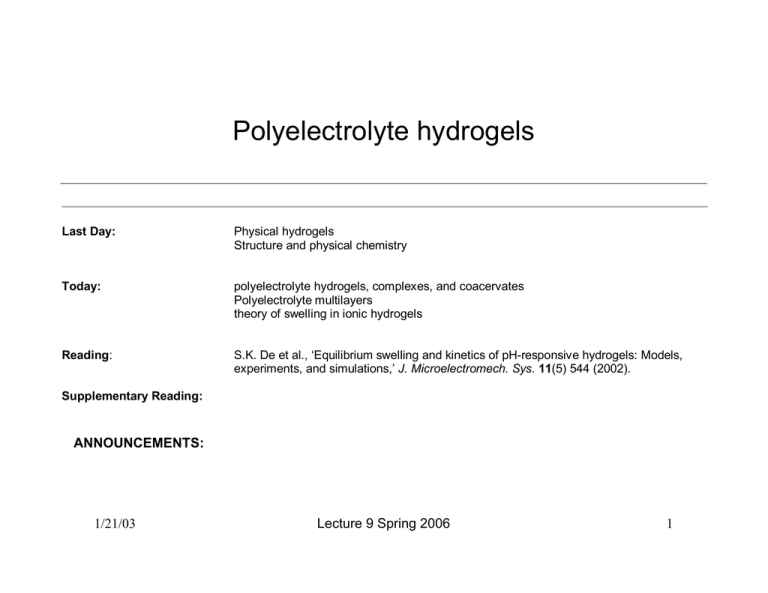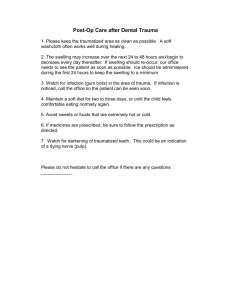Polyelectrolyte hydrogels
advertisement

Polyelectrolyte hydrogels Last Day: Physical hydrogels Structure and physical chemistry Today: polyelectrolyte hydrogels, complexes, and coacervates Polyelectrolyte multilayers theory of swelling in ionic hydrogels Reading: S.K. De et al., ‘Equilibrium swelling and kinetics of pH-responsive hydrogels: Models, experiments, and simulations,’ J. Microelectromech. Sys. 11(5) 544 (2002). Supplementary Reading: L. Brannon-Peppas and N.A. Peppas, ‘Equilibrium swelling behavior of pH-sensitive hydrogels,’ Chem. Eng. Sci. 46(3) 715-722 (1991). ANNOUNCEMENTS: 1/21/03 Lecture 9 Spring 2006 1 Determination of thermodynamic driving force for triblock self-assembly Image removed due to copyright reasons. Please see: Figure 6 and Table 4 in Alexandridis, P., J. F. Holzwarth, and T. A. Hatton. Macromolecules 27 (1994): 2414-2425. 1/21/03 Lecture 9 Spring 2006 2 Determination of thermodynamic driving force for triblock self-assembly 1/21/03 Lecture 9 Spring 2006 3 Hydrophobic association vs. hydrogen bonding gels 1/21/03 Lecture 9 Spring 2006 4 Polyelectrolyte hydrogels 1/21/03 Lecture 9 Spring 2006 5 Common polyelectrolyte gel structures: 1/21/03 Lecture 9 Spring 2006 6 COACERVATES COACERVATES Formation of polyelectrolyte physical gels: self-assembly of coacervate hydrogels Images removed due to copyright reasons: Please see: Chornet, E., and S. Dumitriu. “Inclusion and Release of Proteins from Polysaccharide-based Polyion Complexes.” Adv Drug Deliv Rev 31 (1998): 223-246. 1/21/03 Lecture 9 Spring 2006 7 COACERVATES COACERVATES Microstructure of coacervate hydrogels Chitosan polycation Xanthan polyanion Images removed due to copyright reasons. Please see: Chornet, E., and S. Dumitriu. “Inclusion and Release of Proteins from Polysaccharide-based Polyion Complexes.” Adv Drug Deliv Rev 31 (1998): 223-246. 1/21/03 Lecture 9 Spring 2006 8 COACERVATES COACERVATES Microstructure of coacervate hydrogels Images removed due to copyright reasons. Please see: Chornet, E., and S. Dumitriu. “Inclusion and Release of Proteins from Polysaccharide-based Polyion Complexes.” Adv Drug Deliv Rev 31(1998): 223-246. Images removed due to copyright reasons. Please see: Friedl, P. et al. Eur J. Immunol 28 (1998): 2331-2343. 1/21/03 Lecture 9 Spring 2006 9 PEMs PEMs Layer-by-layer deposition Surface properties dominated by last layer deposited: Image removed due to copyright reasons: Please see: Figure 1 in Schlenoff, Joseph B. "Polyelectrolyte Multilayers.“ AccessScience@McGraw-Hill. http://www.accessscience.com Figure by MIT OCW. θ 1/21/03 Lecture 9 Spring 2006 10 PEMs PEMs Degree of ionization during assembly dictates multilayer structure Charge during assembly can be ‘protected’ in the multilayer: Images removed due to copyright reasons. Please see: Figure 1 in Mendelsohn, Jonas D., Sung Yun Yang, Jeri'Ann Hiller, Allon I. Hochbaum, and Michael F. Rubner. "Rational Design of Cytophilic and Cytophobic Polyelectrolyte Multilayer Thin Films." Biomacromolecules 4 (2003): 96-106. 1/21/03 Lecture 9 Spring 2006 11 Assembly with any charged molecule or particle; PEMs PEMs Conformal modification of complex surfaces Images removed due to copyright reasons. Please see: Khopade, A. J., and F. Caruso. “Stepwise Self-assembled Poly(amidoamine) Dendrimer and Poly(styrenesulfonate) Microcapsules as Sustained Delivery Vehicles.” Biomacromolecules 3 (2002): 1154-1162. 1/21/03 Lecture 9 Spring 2006 12 PEMs PEMs Conformal modification of complex surfaces Image removed due to copyright reasons. Please see: Caruso, F., D. Trau, H. Mohwald, and R. Renneberg. “Enzyme Encapsulation in Layer-by-layer Engineered Polymer multilayer capsules.” Langmuir 16 (2000): 1485-1488. 1/21/03 Lecture 9 Spring 2006 13 PEMs PEMs Hollow PEMs as drug-delivery capsules Image removed due to copyright restrictions. Graph removed due to copyright restrictions. Fluorescent drug-loaded PEM capsules 1/21/03 Lecture 9 Spring 2006 14 PEMs PEMs Cellular substrates Image of SEM micrograph of multilayer-coated echinocyte blood cell removed due to copyright restrictions. (Alberts et al. Molecular Biology of the Cell) 1/21/03 Lecture 9 Spring 2006 15 PEMs PEMs Employing PEMs on degradable biomaterials H 2 N- CH 2 CH 2 -N H 2 CH3 O -(CH -C-O)n- CH3 O H -CH -C-N-CH2CH2-NH2 + HO- 1/21/03 Images removed due to copyright reasons. Please see: Zhu, Y., C. Gao, T. He, X. Liu, and J. Shen. “Layer-by-Layer Assembly to Modify Poly(Llactic acid) Surface Toward Improving Its Cytocompatibility to Human Endothelial Cells.” Biomacromol. 4 (2003): 446-452. Lecture 9 Spring 2006 16 Polyelectrolyte hydrogels -COOH Ka = [RCOO-][H+] [RCOOH] -COO- + H+ pKa = -log Ka pH = pKa + log [RCOO-]/[RCOOH] ionization of charged groups 1.2 1 pKa pKa 0.8 0.6 0.4 0.2 0 0 1/21/03 1 2 3 4 5 6 Lecture 9 Spring 2006 7 pH 8 9 10 11 12 13 14 17 Responsiveness of ‘unpaired’ polyelectrolyte gel structures: pH Ionic strength (-) (-) (-)(-) (-) (-) (-) (-) (-) (-) (-) (-) (-) (-) (-) (-) (-) (-) (temperature) Electric fields (-) (-) (-) (-) (-) (-) (-) (-) (-) E 1/21/03 Lecture 9 Spring 2006 18 Environmental responsiveness of covalent polyelectrolyte networks: experimentally observed swelling of anionic hydrogels [-CH-CH-]mC=O O H Graph removed due to copyright reasons. Please see: De, S. K. et al. “Equilibrium Swelling and Kinetics of pH-responsive Hydrogels: Models, Experiments, and Simulations.” Journal of Microelectromechanical Systems 11 (2002): 544-555. 1/21/03 Lecture 9 Spring 2006 19 Driving force for unpaired polyelectrolyte gel swelling Cl- Cl- OH- OH- Na+ Na+ OH- OH- Na+ (3) H+ (1) -COO- H2O (4) Π (2) OH- 1/21/03 OH- Lecture 9 Spring 2006 20 Swelling behavior reversed in polycation hydrogels S pH 1/21/03 Lecture 9 Spring 2006 21 Kinetics of swelling/deswelling transitions Graphs removed due to copyright reasons. Please see: De, S. K. et al. “Equilibrium Swelling and Kinetics of pH-responsive Hydrogels: Models, Experiments, and Simulations.” Journal of Microelectromechanical Systems 11 (2002): 544-555. 1/21/03 Lecture 9 Spring 2006 22 Kinetics of swelling/deswelling transitions Rapid swelling/deswelling of superporous gels: Low pH High pH Graph removed due to copyright reasons. Please see: Figure 2 in Zhao, B., and J. S. Moore. “Fast pHand Ionic Strength-responsive Hydrogels in Microchannels.” Langmuir 17(2001): 4758-4763. 1/21/03 Lecture 9 Spring 2006 23 thermodynamics of ionic hydrogels external solution Model of system: (-) gel (-) (-) (-) (-) (-) (-) (-) (-) Inorganic anion, e.g. ClInorganic cation, e.g. Na+ water 1/21/03 Lecture 9 Spring 2006 24 Swelling of polyelectrolyte gels is controlled by ionic strength and degree of ionization of the gel: 1/21/03 Lecture 9 Spring 2006 25 Equilibrium condition: 1/21/03 Lecture 9 Spring 2006 26 A 200 pKa = 2 4 100 10 6 8 0 Equilibrium Swelling Ratio (Q) Equilibrium Swelling Ratio (Q) Q = swollen volume of system/dry polymer volume = 1/ φ2,s B I = 0.05 1200 0.1 600 0.25 0.5 0.75 1 2 0 1 3 5 7 9 11 Equilibrium Swelling Ratio (Q) pH of Swelling Medium C 200 100 x1 = 0.1 0.3 0.9 0.45 0.8 0.6 0 1 3 5 7 9 11 pH of Swelling Medium Theoretical Swelling Predictions at Comparable Ionic Strength Conditions for an Anionic Network After Brannonpeppas, L., and N. A. Peppas. “Equilibrium Swelling Behavior of Ph-Sensitive Hydrogels.” Chemical Engineering Science 46 (1991): 715-722. 1/21/03 Lecture 9 Spring 2006 Figure by MIT OCW. 27 PE hydrogels as environment-responsive materials: applications in biotechnology and bioengineering 1/21/03 Lecture 9 Spring 2006 28 bioMEMS based on polyeletrolyte gel responses Images removed due to copyright reasons. Please see: Figure 1 and Figure 2 in Beebe, D. J., et al. “Functional Hydrogel Structures for Autonomous Flow Control Inside Microfluidic Channels.” Nature 404 (2000): 588-+. 1/21/03 Lecture 9 Spring 2006 29 bioMEMS based on polyeletrolyte gel responses Image removed due to copyright reasons. Please see: Figure 12 in Beebe, D. J., G. A. Mensing, and G. M. Walker. “Physics and Applications of Microfluidics in Biology.” Annual Review of Biomedical Engineering 4 (2002): 261-286. 1/21/03 Image removed due to copyright restrictions. Please see: Figure 4 in Beebe, D. J., et al. “Functional Hydrogel Structures for Autonomous Flow Control Inside Microfluidic Channels.” Nature 404 (2000): 588-+. Lecture 9 Spring 2006 30 Further Reading 1. 2. 3. 4. 5. 6. 7. 8. 9. 10. 11. 12. 13. 14. 15. 16. 17. 1/21/03 De, S. K. et al. Equilibrium swelling and kinetics of pH-responsive hydrogels: Models, experiments, and simulations. Journal of Microelectromechanical Systems 11, 544-555 (2002). Tanaka, T. & Fillmore, D. J. Kinetics of Swelling of Gels. Journal of Chemical Physics 70, 1214-1218 (1979). Zhao, B. & Moore, J. S. Fast pH- and ionic strength-responsive hydrogels in microchannels. Langmuir 17, 4758-4763 (2001). Chornet, E. & Dumitriu, S. Inclusion and release of proteins from polysaccharide-based polyion complexes. Adv Drug Deliv Rev 31, 223-246. (1998). Zhu, Y., Gao, C., He, T., Liu, X. & Shen, J. Layer-by-Layer assembly to modify poly(Llactic acid) surface toward improving its cytocompatibility to human endothelial cells. Biomacromol. 4, 446-452 (2003). Khopade, A. J. & Caruso, F. Stepwise self-assembled poly(amidoamine) dendrimer and poly(styrenesulfonate) microcapsules as sustained delivery vehicles. Biomacromolecules 3, 1154-1162 (2002). Caruso, F., Trau, D., Mohwald, H. & Renneberg, R. Enzyme encapsulation in layer-bylayer engineered polymer multilayer capsules. Langmuir 16, 1485-1488 (2000). Elbert, D. L., Herbert, C. B. & Hubbell, J. A. Thin polymer layers formed by polyelectrolyte multilayer techniques on biological surfaces. Langmuir 15, 5355-5362 (1999). Wang, Y. F., Gao, J. Y. & Dubin, P. L. Protein separation via polyelectrolyte coacervation: Selectivity and efficiency. Biotechnology Progress 12, 356-362 (1996). Beebe, D. J. et al. Functional hydrogel structures for autonomous flow control inside microfluidic channels. Nature 404, 588-+ (2000). Beebe, D. J., Mensing, G. A. & Walker, G. M. Physics and applications of microfluidics in biology. Annual Review of Biomedical Engineering 4, 261-286 (2002). James, H. M. & Guth, E. Simple presentation of network theory of rubber, with a discussion of other theories. J. Polym. Sci. 4, 153-182 (1949). Flory, P. J. & Rehner Jr., J. Statistical mechanics of cross-linked polymer networks. I. Rubberlike elasticity. J. Chem. Phys. 11, 512-520 (1943). Flory, P. J. & Rehner Jr., J. Statistical mechanics of cross-linked polymer networks. II. Swelling. J. Chem. Phys. 11, 521-526 (1943). Brannonpeppas, L. & Peppas, N. A. Equilibrium Swelling Behavior of Ph-Sensitive Hydrogels. Chemical Engineering Science 46, 715-722 (1991). Peppas, N. A. & Merrill, E. W. Polyvinyl-Alcohol) Hydrogels - Reinforcement of RadiationCrosslinked Networks by Crystallization. Journal of Polymer Science Part a-Polymer Chemistry 14, 441-457 (1976). Ozyurek, C., Caykara, T., Kantoglu, O. & Guven, O. Characterization of network structure of poly(N-vinyl 2-pyrrolidone/acrylic acid) polyelectrolyte hydrogels by swelling measurements. Journal of Polymer Science Part B-Polymer Physics 38, 3309-3317 (2000). Lecture 9 Spring 2006 31







